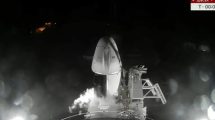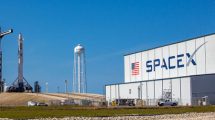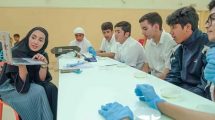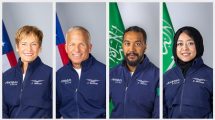 UAE high school student Alia Al Mansoori’s experiment is on its way to the International Space Station. This is the culmination of the first UAE Genes in Space competition held in the UAE and made possible through a partnership of the UAE Space Agency, The National and Boeing.
UAE high school student Alia Al Mansoori’s experiment is on its way to the International Space Station. This is the culmination of the first UAE Genes in Space competition held in the UAE and made possible through a partnership of the UAE Space Agency, The National and Boeing.
The DNA-based research competition was open to all students in Grades 7 through 12 across the country. The contest invited students to propose experiments that contribute to solving real-life space exploration problems.
The experiment by Al Mansoori, 15, of Al Mawakeb School Al Barsha in Dubai, will be the third award winner to fly an experiment to the ISS under the auspices of the Genes in Space competition and the first outside the United States. Al Mansoori’s experiment will examine DNA produced in space for changes in protein expression. The results may provide clues on how to prevent unwanted cell death in order to keep future astronauts healthy during long-duration missions into deep space, including flights to Mars.
Al Mansoori worked with scientists from miniPCR to prepare her experiment for launch and operations aboard the station. Working with a miniPCR DNA replicator smaller than a glove box, astronauts will create numerous chains of DNA on orbit to see how they change. Al Mansoori said UAE Genes in Space inspired her by offering the opportunity to potentially help future astronauts reach Mars safely.
“The need to explore connects us all as humans and it inspires us in different ways to pursue advances,” said Al Mansoori. “I looked at how astronauts might need to be protected while in space, or at least offer them a way to see what changes are taking place in their bodies. Knowing that, it may be possible to prevent such damage from taking place at all.”
H.E. Dr. Ahmad Belhoul Al Falasi, Minister of State for Higher Education and Chairman of the UAE Space Agency, said: “The UAE Space Agency’s organization and backing of this competition comes as part of the UAE’s comprehensive efforts to support its ambitious youth and their endeavors. This competition has highlighted the deep interest among our youth in a range of applied space sciences and technologies. These fields are a foundation of national growth that will advance our strong international standing.”
H.E. Dr. Al Falasi noted that the national space sector has made a number of significant achievements in improving national capacities and raising public awareness of the space sector, particularly among the country’s youth. In this regard, the competition has directly supported and advanced the Space Agency’s strategic objectives to develop human capital throughout the national space sector.
The Space Agency Chairman went on to express his pride in the nation’s youth. By participating in international events such as this, they have proved their capabilities and merit, and have contributed to raising the UAE’s profile, he added.
H.E. Dr. Mohammed Al Ahbabi, Director General of the UAE Space Agency, said: “One of our core mandates is to develop national and regional capacities in advanced STEM fields and space sciences. UAE Genes in Space represented a perfect opportunity to engage with younger generations on these crucial issues. The fact that it is the first edition to take place outside of the United States is a reflection of the progress that has been made throughout our burgeoning space sector.”
Al Mansoori’s research effort will follow in the successful paths of Anna-Sophia Boguraev, who won the inaugural Genes in Space competition in 2015, Julian Rubinfein, who won the 2016 competition, as well as the two individual winners of the 2017 Elizabeth Reizis and Sophia Chen. The students worked with accomplished scientists from MIT, Harvard and Yale University, who mentored them to get their projects prepared and then performed on orbit aboard the unique microgravity environment offered by the station. The research resulted in published scientific reports to ensure the students’ findings are available to researchers working to decipher the riddles of human spaceflight.
“The students who take part in this competition bring so much imagination and creativity to the research they propose that I think it drives all of us to work that much harder to make sure the experiment is successful and knowing that the results are making a meaningful contribution to science and the future of human space exploration,” said Bernard Dunn, Boeing’s president for MENAT Region.












Add Comment